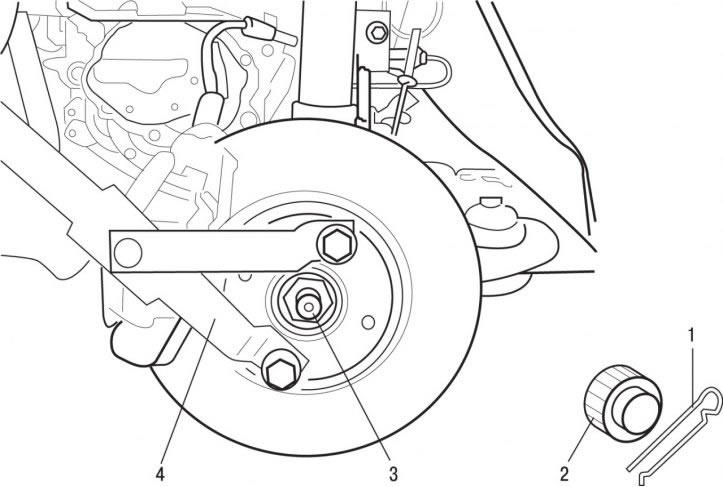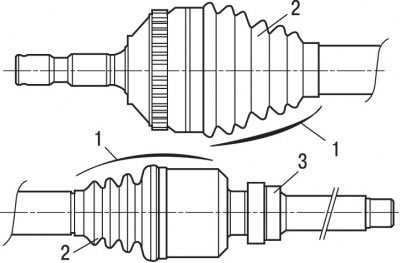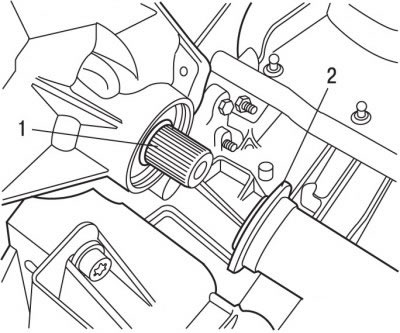- with the vehicle on the ground, apply the parking brake and loosen the front wheel mounting bolts;
- raise the car on a lift;
- remove the front wheels;

Pic. 6.7. Fastening the device that fixes the hub from turning: 1 - cotter pin; 2 - cap; 3 - nut, 325 Nm; 4 - a device that fixes the hub from turning
- remove cotter pin 1 (see fig. 6.7) and remove the cap 2 that secures the axle shaft nut to the hub from unscrewing;
- using fixture 4, fix the hub from turning and loosen and then unscrew the nut 3 securing the axle shaft to the front wheel hub;
Attention! It is forbidden to use the brake to fix the hub from turning while unscrewing the nut 3 - this can lead to shearing of the brake disc fastening bolts.

Pic. 5.66. Nut location (1) fastenings of an intermediate support of the right semiaxis
- turn out as much as possible, but do not remove the nuts 1 (pic. 5.66) fixing the intermediate support of the right axle shaft;
- turn the bolts 90°so that their heads are offset from the outer end of the bearing;

Pic. 5.67. Bolt location (1) fastening the lower part of the suspension strut to the steering knuckle
- mark the position of the bolts securing the lower part of the suspension strut to the steering knuckle. Holding the bolts from turning with one wrench, unscrew the nuts with the second wrench 1 (pic. 5.67). To prevent the lowering of the steering knuckle with a soft wire, secure it to the subframe. Remove the bolts securing the lower part of the shock absorber to the steering knuckle;
- when removing the right half shaft, turn the front wheels to the left until they stop;
- when removing the left axle, turn the front wheels to the right until they stop;
- Remove the nut securing the steering knuckle ball joint to the lower transverse arm. Using a ball joint puller, remove the steering knuckle ball joint trunnion from the lower arm. Using the ball joint release lever, separate the lower transverse arm from the steering knuckle ball joint. At the same time, do not damage the protective cover of the constant velocity joint;
- tilt the steering knuckle to the side and remove the axle shaft from the front wheel hub;
- on vehicles with a manual transmission, drain the oil from the gearbox;
Attention! The AL4 automatic transmission is sealed, so it does not make sense to drain the oil from it for this operation.
- while supporting, remove the axle shaft from the gearbox, without damaging the sealing ring, and remove the shaft from the vehicle. If necessary, use a rubber mallet or mallet to remove the axle shaft from the hub.
Installation of the axle shaft is carried out in the reverse order of removal, taking into account the following:

Pic. 5.68. Joints of equal angular speeds of the drive shaft: 1 - hinge of equal angular velocities; 2 - corrugated protective cover; 3 - the outer ring of the bearing
- make sure that in CV joints 1 (pic. 5.68) there is no backlash;
- check the condition of the corrugated protective covers 2;
- check the freedom of rotation of the bearing of the right axle shaft support. If the bearing seizes or noticeable axial play is felt, then it should be replaced;
- clean and lubricate with universal grease the splines of the hub and half shaft on the wheel side, as well as the splines of the planetary gears of the differential and half shafts on the gearbox side;
- before installing the right axle shaft, clean and lubricate with multifunctional grease the outer ring of the support 3 bearing and its seat in the lower right engine mount;

Pic. 5.69. O-ring location (1) and dust ring (2) axle shafts
- when installing the right axle shaft, check the presence and condition of the sealing ring 1 (pic. 5.69) and dustproof ring 2;
- check up a condition of a protective cover of a spherical hinge of a rotary fist;
- install the axle shaft in the differential, aligning the splines of the axle shaft with the grooves of the planetary gears of the differential;
- check that the intermediate bearing rotates easily and evenly and that there is no play of the outer ring in relation to the inner one;
- check the correct installation of the intermediate bearing, then turn the bolts by 90°and fix them in this position with the nuts, tightening them with a torque of 10 Nm;
- with tool 4 (see fig. 6.7) fix the hub from turning and screw and tighten the nut securing the drive shaft to the hub with a torque of 325 Nm;
- lock the nut by crimping the shoulder into the slots of the splined end of the axle shaft, or secure with a cap and cotter pin;
- install the wheels and fasten with bolts, tightening them with a torque of 90 Nm;
- on vehicles with a manual transmission, fill the gearbox with oil.
